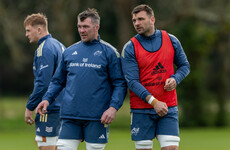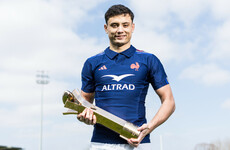OVER THE LAST two days, we have examined the options available to Andy Farrell in the front row and second row in his Ireland squad for the upcoming Six Nations.
Today on The42, we turn to the back row, where Farrell has some fascinating decisions to make.
__________
Back row
Caelan Doris [Leinster, 0 caps]
Max Deegan [Leinster, 0]
Jack O’Donoghue [Munster, 2]
Peter O’Mahony [Munster, 64]
CJ Stander [Munster, 38]
Josh van der Flier [Leinster, 23]
This discussion-provoking group of back rows represent possible continuity on one hand and a fresh start on the other.
O’Mahony, Stander, and van der Flier were Ireland’s first-choice back row at the World Cup. The uncapped Deegan and Doris are completely new faces, while Munster’s Jack O’Donoghue is back in the mix having won his only two caps in 2016 and 2017.
As with other areas of the team, Farrell must decide whether to continue with the more experienced players who finished the Joe Schmidt era as starters or put his own stamp on the XV with some statement selection calls.
Van der Flier is the favourite to start at openside thanks to his good form for Leinster since the World Cup. He is the only pure seven in the squad, although O’Mahony, O’Donoghue, and Deegan can play there too.
Van der Flier has looked more dynamic recently. He is not a heavy-duty carrier in tight channels but eight clean linebreaks this season show he is bringing punch in possession, as well as running smart support lines. Van der Flier is a hard-working and consistent defender, tackling at a 94% success rate.
The 26-year-old Leinster man has been working on his breakdown skills and six jackal turnovers for his province are evidence of improvement – which he needs to bring into Test rugby. Van der Flier is not as a strong lineout option, jumping just once so far this season, which needs to be considered in Ireland’s back row make-up.
Stander is the incumbent at number eight for Ireland and continues to be a workhorse for his country and Munster. He has racked up 989 minutes of action within the current season, 100 more than next busiest Max Deegan.
Stander is a relentless ball-carrier and has made a remarkable 225 carries this season, again well clear of Deegan on 130. Stander’s average gain of 1.80 metres per carry is not to be sniffed at given how frequently he is carrying into heavy traffic, but his footwork could be better.
29-year-old Stander wins the gainline very often and that is something all coaches value. Though not possessing the most fluid of handling skills, the Munster man has passed 55 times this season and offloaded on eight occasions, and this may be an area Farrell and attack coach Mike Catt look to develop further in terms of accuracy.
Stander is a reliable and often impactful defender, while he offers a breakdown threat and has four jackal turnovers this season. The 29-year-old was predominantly a blindside flanker for Ireland before Jamie Heaslip’s retirement and Farrell may consider shifting him back into the number six jersey, asking him to focus on causing destruction.
While not the tallest at 6ft 1ins, Stander can jump at lineout time – he has won 11 lineouts this season – so can contribute there, or as the receiver behind the lineout ready to set up a maul.
If Stander is to be shifted, Doris and Deegan will be eyeing a debut chance at number eight. Both are enjoying superb seasons, with 21-year-old Doris appearing to be slightly ahead in the number eight pecking order at Leinster.
Doris’ average gain of 3.5 metres per carry is the best of any forward in Ireland’s squad, though it’s worth stressing that the majority of his 743 minutes have come in the Pro14. Doris is a robust, aggressive carrier who also possesses good footwork and decision-making, helping him to beat 31 defenders and make 5 linebreaks in his 117 carries.
Four offloads and 18 passes have allowed him to show a good skill level on the ball, while Doris picks intelligent running lines. His back-row leading 96% tackle success rate hints at the power and consistency of his defensive work too.
With six jackal turnovers this season, Doris is a genuine breakdown threat, while he has won 16 lineouts for Leinster and is clearly a fine option in the set-piece, having worked hard to develop his lineout understanding and jumping to utilise his 6ft 4ins height.
In summary, Doris is a very rounded number eight. He makes life easier for those around him, in the mould of Kieran Read or Jamie Heaslip. His potential is exciting for Irish rugby and he appears ready for a shot in this Six Nations.
Deegan shouldn’t be discounted for a role at number eight or elsewhere, having played in all three back row positions for Leinster. 23-year-old Deegan is a different player to Doris.
His impressive stats of 12 clean breaks, 24 defenders beaten, four try assists, 27 passes and two offloads read almost like those of a centre, where the classy Deegan could probably play very effectively.
Deegan has sharp footwork that allows him to survive in tight channels but he really excels in wider positions on the field, where his change-up and dynamism are prominent. Also 6ft ins tall, he is a good lineout option, with 19 wins at the set-piece this season.
At 87.3%, he has the lowest tackle success rate of Ireland’s back rows although he is working hard to develop an effective chop-tackling technique. He doesn’t yet offer a jackal threat, with no successful breakdown turnovers so far in this campaign.
The return of Waterford man O’Donoghue to the Ireland squad has been well-earned with his excellent performances for Munster, where he is arguably the form back row.
Used in all three back row position by his province, O’Donoghue’s acceleration looks better than ever this season, helping him to nine clean linebreaks and 14 defenders beaten, while he is averaging a gain of 2.40 metres per carry.
One area of the 25-year-old’s game that has vastly improved since his caps against Canada and Japan in 2016/17 is his lineout work. He is now an excellent jumping option and has also made three steals in the air this season. On top of that, O’Donoghue is a superb maul defender and regularly forces turnovers in this area.
He doesn’t quite have the impact of some of his rivals in the tackle, with an 88.4% success rate, while Farrell will push him to improve his discipline, with O’Donoghue having conceded 19 penalties this season. O’Mahony [11] is the only other player who has conceded more than 10 penalties in the current campaign.
O’Mahony’s role for Ireland under Farrell will be of particular interest. The Munster captain has been first-choice at blindside since Stander moved to number eight when Heaslip suffered an injury at the end of the 2017 Six Nations but he is under more pressure than ever.
Of prime concern is O’Mahony’s relatively poor ball-carrying. With an average gain of 1.48 metres per carry this season, he has been statistically the least effective carrier of the Ireland back rows, while his six defenders beaten and one linebreak are also bottom of the charts.
The 30-year-old is often positioned close to the touchline within Munster’s attacking shape, where he doesn’t appear totally comfortable or happy, but his carrying in tight channels is not a strength either.
O’Mahony isn’t a huge hitter compared to others in the Ireland squad, with an 87.7% tackle rate, but he does bring other major defensive qualities that are not matched by his back row rivals.
O’Mahony has won eight jackal turnovers at the breakdown this season, while his 10 lineout steals make him the leading defensive jumper in the squad, leaving him ahead of James Ryan on seven. O’Mahony has also won 28 lineouts this season, which is more than Iain Henderson and only a short way behind Ryan [33].
Whether Farrell values O’Mahony’s lineout skills and breakdown threat enough to overlook his relative lack of impact in the carry and tackle remains to be seen.
The Munster man is also highly-regarded as a leader and he has captained Ireland on several occasions. Those mental factors are less tangible to those of us on the outside of the squad but a coach like Farrell understands the value of having strong personalities in a team.
With the form of Doris, Deegan, and O’Donoghue, Farrell certainly has scope for change in the back row, although the Test level experience of incumbents like O’Mahony and Stander shouldn’t be discounted.
Playing international rugby is a major step up from excelling in the Pro14 and impressing in the Champions Cup, something Farrell must weigh up. That said, a player’s first Test opportunity has to come at some stage.
A potential back row composed of Stander at blindside, Doris at number eight, and van der Flier at openside would offer a balance of ball-carrying ballast, powerful tackling, work-rate, lineout options, breakdown threats, and some handling skill.
The bench role will be important for Ireland too, with O’Donoghue and Deegan offering cover across all three back row positions, while O’Mahony, Stander, Doris, and even van der Flier would all have their merits as replacements offering different qualities.
Possible Ireland back row v Scotland: Stander, van der Flier, Doris.
Possible bench back row v Scotland: Deegan.















Only took up golf 4 years ago? Jesus that’s a sucker punch to the rest of us
I only took it up 25 years ago and I’m off 15 already… So…
Can we send him to the olympics!
On team GB maybe!
Not exactly a prodigy…hes one of the top 10 U14s in the country. He just happens to be a member of Rorys home club.
Rory doesn’t know where home is
British golf looks promising.